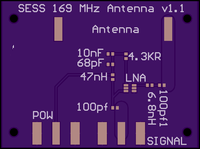I am trying to design and build an antenna + LNA board.
Antenna: http://www.yageo.com/documents/recent/An_FR4_1690_2405_0.pdf
LNA: http://www.avagotech.com/docs/AV02-1237EN
The antenna is specced to run at 168 MHz. In the LNA documentation it provides a suggested circuit for a 500 MHz signal. The suggested circuit is below. My Antenna feeds into the left, and my output is on the right. In building the board following the suggested circuit, only my trace between my antenna and the start of the LNA circuit and the trace between the end of the LNA circuit and my output SMA are 50 ohm traces.

My Question is basically why isn't this working? Am I missing some vital piece of information I have no considered? Given that the circuit is designed for 500 MHz I would expect lesser performance with a 168 MHz signal, however I am unable to pick up any signals.
My test setup consists of an RF generator with an antenna attached, and a network analyzer with this antenna design attached. These two components sit a few feet apart.
I believe all of my soldering connections are correct, and I have confirmed that the board is receiving the appropriate amount of power.
An Image of My board. Dimensions are roughly 1.5"x1.25" and all of my components are 0204 size.

So to recap, I receive no signals on this board even when I am blasting on my RF source right next to it. I have tested other antennas to verify that the broken piece is indeed this new antenna design. Could the mismatch between the frequency used to build the recommended circuit and the frequency my board is running at really eliminate all signals? Or is there some aspect of antenna design that this novice is glossing over?
Any thoughts would be appreciated!